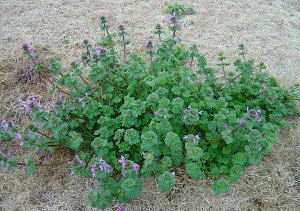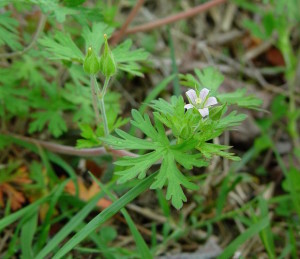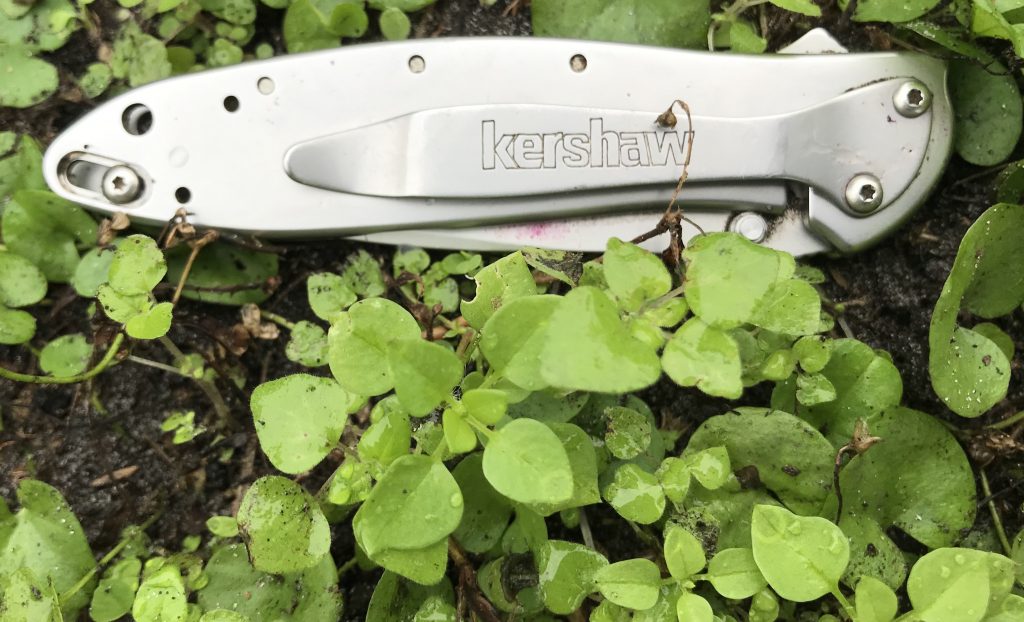
Chickweed is just staring its seasonal run. Photo by Green Deane
Our first sighting of one of our winter comestibles happened Saturday. Just an inch or so high Chickweed is coming up. A spring edible up north it’s just too warm most of the year here for Chickweed to sprout. It takes several cold nights to chill the top couple of inches of ground for it to start growing. Another winter annual, Pellitory, is well up and several inches high in many places. We haven’t seen our third winter Musketeer, Stinging Nettles but it will be soon. We’ve also spotted Swine Cress, too. Soon it will be Wild Mustard and Sow Thistle time. To read more about Chickweed go here.
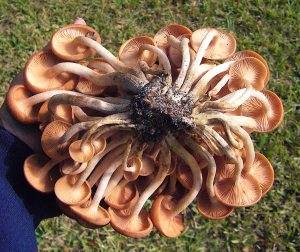
These prime Ringless Honey Mushrooms are cespitose, all growing out of one spot. Photo by Green Deane
Despite being well past the season we are still finding Ringless Honey Mushrooms. The cespitose mushroom (grows like a bouquet) usually flushes in the first week or so of November. It was a couple of weeks early. Now a month past its common time and it’s still popping. We found some Sunday in New Port Richey. They can also have a minor flush in April or so dependent on the weather. We are often told a lot about the vitamin D content of mushrooms and Ringless Honey Mushrooms have some, about 0.172 mg per gram. However it has far more vitamin C, 16 mg per gram. That means one mushroom could meet your daily need for vitamin C. Not a bad deal. You can read more about Ringless Honey Mushrooms here.
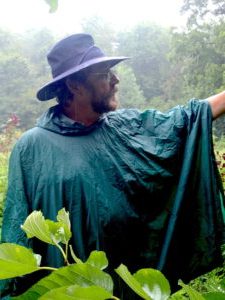
Classes are held rain, shine or cold.
Foraging Classes this week are both on the east coast. The weather will be warming up so they should be enjoyable. Saturday’s class is in West Palm Beach. It rarely freezes there so we can see some tropical species. Sunday’s class is one I don’t do too often because we have to go inside a federal park and then change locations twice. We start at Turtle Mound then go south to visit the beach side and then end at Eldora, which was once a thriving community on the inland coastal waterway.
Saturday, December 12th, Dreher Park, 1200 Southern Blvd., West Palm Beach, 33405. 9 a.m. to noon. Take exit 68 (Southern Boulevard) off Interstate 95 and go east. Entrance to the park is an immediate right at the bottom of the interstate bridge. Follow the convoluted signs to the science center (which is not where the GPS puts you.) Park anywhere. We meet 300 feet northwest of the science museum near the banyan trees.
Sunday, December 13th, Turtle Mound: Canaveral National Seashore Park, New Smyrna Beach Fl. 9 a.m. to noon. A foraging class at this location requires some flexibility. There is a fee to get into the park. We start at Turtle Mound but there is limited parking. However, there is a ranger station visitor center just south of the mound with parking there, too. After the mound we will drive to the next beachside parking area to look around. Then we move a second time to visit what is left of Eldora once a busy town on the inland waterway.
Saturday, December 19th, Bayshore Live Oak Park, Port Charlotte, 9 a.m. to noon. Meet at the parking lot at the intersection of Bayshore and Ganyard Street.
Sunday, December 20th, Mead Gardens, 1500 S. Denning Dr., Winter Park, FL 32789. 9 a.m. to noon. The entrance is on the west side off Denning not the east side off Pennsylvania. Some GPS maps are wrong. Meet near the bathrooms.
Sunday, December 27th, Ft. Desoto Park, 3500 Pinellas Bayway S. St. Petersburg Fl 33715. 9 a.m. to noon. There is an entrance fee to the park. After you enter the park you arrive at a T-intersection. Turn right. Close to a mile later on your left is the fishing pier and parking lot. Meet near the bathrooms. There is considerable walking at this location.
For more information, to prepay or to sign up go here. Don’t forget Dec.18th is my 10th annual Urban Crawl. It’s a free class in downtown Winter Park, starts at 10 a.m. in front of Panera’s
This time of year two wintertime foragables come up, one quite esteemed the other barely edible. They can at first glance look similar so I’ll mention them together.
The first is Henbit. It’s in the mint family but does not smell or taste minty. It does, however, have a square stem and the blossoms resembles mints. In northern climates it is one of the first green plants to pop up after the snow goes (it and chickweed.) Locally it likes our cooler months of the year. It was esteemed by the natives because among all the annual greens it is not spicy but rather mild if not on the sweet side. What can be confusing about it is that the leave shape and stem length is different from young to old leaves. But they all have a scalloped shape. It also has a similar looking relative that is also edible called Dead Nettle. You can read about Henbit here.
Also found in lawns this time of year are wild geraniums, usually Cranesbill or Stork’s Bill. (Why one is one word and the other two-words possessive I do not know.) Botanically they are Geranium carolinianum and Erodium circutarium. Neither is great foraging. In fact both are more medicinal than edible but they seem to get mention in a variety of foraging books. The problem is they are extremely bitter. You might be able to toss a little bit of both in a salad but that’s about the extent of it. If you have what you think is a Cranesbill or a Stork’s Bill but it has more of a bottle brush blossom than five petals you might have the non-edible Fumaria. It comes up this time of year and from a distance the leaves can remind one of the wild geraniums. To read more about them go here.
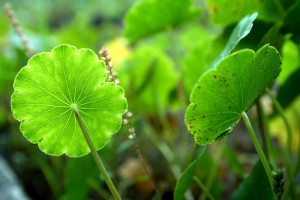
Dollarweed has its stem in the middle.
Botany Builder #30: Peltate, shield-like. When the ancient Greeks fought they did so in a line holding a spear-like pole in the right hand, and a round shield in the left held by a handle in the middle. In fact the Greek word for “okay” means “in line.” Usually a peltate leaf has the stem attached to middle on the underside, like the common dollar weed. Websites say peltate comes from the Dead Latin “Pelta” meaning a small light shield. No. It comes from the older Greek word Peltos, meaning shield. Greeks were defending themselves with peltos centuries before the Roman’s came along.
From The ETW’s Archives: Is this Plant Edible? That is surprisingly not an easy question to answer. Where, when and what is rather important. To read more about that go here.

Green Deane videos are now available on a USB.
A 150-video USB or 135 video DVD set would be a good winter present and either is now $99. My nine-DVD set of 135 videos has been selling for seven years and are still available. They are the same videos I have on You Tube. Some people like to have a separate copy. A second option is a16-gig USB that has those 135 videos plus 15 more. While the videos can be run from the DVDs the videos on the USB have to be copied to your computer to play. They are MP4 files. The150-video USB is $99 and the 135-video DVD set is now $99. The DVDs will be sold until they run out then will be exclusively replaced by the USB. This is a change I’ve been trying to make for several years. So if you have been wanting the 135-video DVD set order it now as the price is reduced and the supply limited. Or you can order the USB. My headache is getting my WordPress Order page changed to reflect these changes. We’ve been working on it for several weeks. However, if you want to order now either the USB or the DVD set make a $99 “donation” using the link at the bottom of this page or here. That order form provides me with your address, the amount — $99 — tells me it is not a donation and in the note say if you want the DVD set or the USB.

Green Deane Forum
Want to identify a plant? Perhaps you’re looking for a foraging reference? You might have a UFO, an Unidentified Flowering Object, you want identified. On the Green Deane Forum we — including Green Deane and others from around the world — chat about foraging all year. And it’s not just about warm-weather plants or just North American flora. Many nations share common weeds so there’s a lot to talk. There’s also more than weeds. The reference section has information for foraging around the world. There are also articles on food preservation, and forgotten skills from making bows to fermenting food.
This is weekly newsletter #435. If you want to subscribe to this free newsletter you can find the sign-up form in the menu at the top of the page.
To donate to the Green Deane Newsletter click here.

